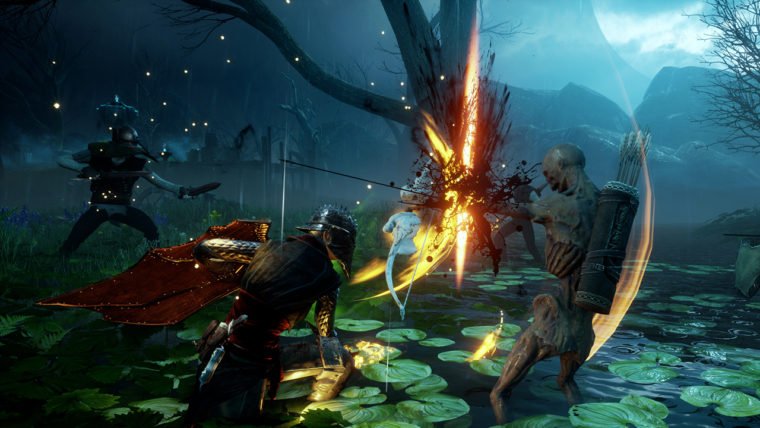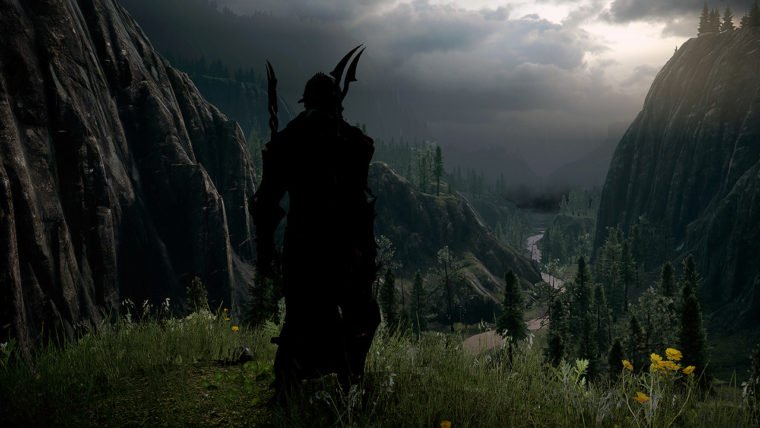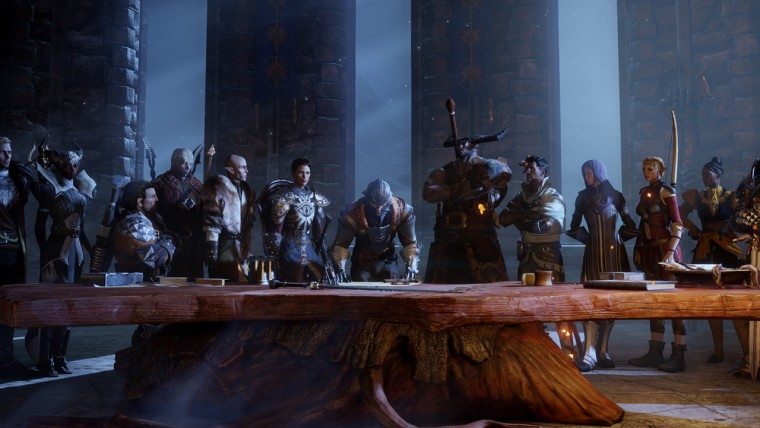The Hero of Ferelden. The Champion of Kirkwall. These are titles cemented in Dragon Age entries of past. And now Dragon Age: Inquisition presents you with another savior whose legend you shall surely remember: the Herald of Andraste. Following not too long after the events of Dragon Age 2 (a decade since Origins, for further reference), Inquisition sees the Templars and mages meet at the Temple of Sacred Ashes for a negotiation of peace lead by the head of the Chantry, Divine Justinia V. The proceedings do not go as planned and are prematurely ended by a mysterious explosion, leaving a massive demon-spewing rift in the sky. The only survivor of this catastrophic event is you, a hero in the making falling under one of four highly customizable races: human, elf, dwarf and Qunari. In addition to memory loss, the soon-to-be Inquisitor has been endowed with a magical marking which holds the ability to close the rifts opening up across Thedas. And so begins the lengthy tale of the rebirth of the Inquisition.
Players will take on a pivotal role in the Inquisition’s shift from a whisper of rebellion to a booming voice of authority and guidance. It’s a massive undertaking, one that sees political activities and narrative-changing decisions spanning Ferelden and Orlais. The first of these decisions involves gaining the support of the Templars or rebel mages. An enemy of unprecedented power is threatening everyone’s existence, after all. Allies are kind of a must. These factions shouldn’t be expected to team up with a group of nobodies, however. As the head of the newly reformed Inquisition, it’s up to you to gain influence and forge alliances. Nearly every action in the game provides influence, expanding the Inquisition’s reach.
As the head of the Inquisition, it’s up to you to gain influence and forge alliances.
In addition, Power and Inquisition Perks are earned through various efforts, ranging from establishing camps to more massive blows against the enemy. A certain amount of Power must be accumulated to access certain missions, usually forcing the player to explore the world and find ways to stabilize the turbulent land. Although I say “force”, it never felt like a chore. In fact, it was just the opposite. The beauty of the environments coupled with the extensive lore tucked within seemingly insignificant quests creates an engaging experience regardless of how many hours have already been invested or how often the area has been visited. Don’t expect to walk too far before running into a book, note or loose-lipped NPC that is readily waiting to further flesh out this living and breathing fantasy world. Inquisition Perks, on the other hand, are doled out more sparingly. These perk points can be spent on various enhancements. Inventory increases, merchant discounts, extra potion slots and more can be obtained through this feature.
I have to say, this is where one of my gripes against the game appears. It isn’t in the Inquisition Perks system itself. The game fails to provide a storage chest to players, despite tossing them into a fully customizable fortress that houses every other Inquisitor-based need. It is worth noting that storage was added to Origins post-launch and Dragon Age 2 had this feature from the start. So its absence in the third game is puzzling. If you’re like me, you will want to pick everything up, but that starting sixty item limit will put an end to that quickly. Having to increase inventory slots via perks is an annoyance, albeit a small one in the grand scheme of things. Still, being able to save some of the unique gear from my greatest conquests could have added to the experience.
You get the opportunity to mold your character into a forgiving, or harsh leader.
Fortunately, the Inquisitor is more than the depth of his/her pockets. This growing figure oversees more and more operations of great importance as the game goes on. The War Council is where our protagonist and his closest friends meet to discuss the next move. A map of Thedas is laid out with pins showing points of interest. Agents can be sent out to these points for any number of reasons, including environment scouting and material retrieval. Those familiar with Assassin’s Creed: Brotherhood’s system of sending assassin recruits on contract missions will have a fairly solid idea of what to expect here. Eventually the Inquisitor’s exploits will bring criminals before his/her throne for judgement. This is just another entertaining aspect of the game that lets players dive further into molding their character into a forgiving or harsh leader.
I apologize if I have made the Herald of Andraste sound like a glorified pencil pusher who hides behind a throne, shouting orders from within the safety of a stronghold. That is simply not true. Our hero isn’t afraid of riding on to the battlefield. Combat is, as you would imagine, a key pillar to this Dragon Age entry. BioWare has not only taken cues from the tactical view of Origins and the sequel’s action-oriented battle system, but has provided a meaningful evolution to both. Combat is quick, impactful and satisfying when played in real-time through normal third-person means. Lifting a shield to absorb an incoming blow and returning with a skull-shattering shield bash feels as wonderful as it should. The other mode allows for an overhead, tactical view of the paused battle. Abilities and character placement and be assigned before watching it all play out. Orchestrating assaults in this way can be immensely rewarding when the character combos are executed perfectly for massive damage. It affords greater control of how each skirmish unfolds, and almost seems a must for the boss battle-esque dragon encounters, although the automatic character behavior is notably competent. For those wondering, party members can be switched between regardless of which mode you prefer to use.

Combat is a key pillar to Inquisition, and it’s quick, impactful and satisfying
It is important to fill your party with characters that best compliment the protagonist, but to be honest I found myself selecting those I liked the most while trying to maintain an acceptable balance of skill sets. And I have no doubt that you will, too, because each character in Dragon Age: Inquisition has a distinct personality. Varric’s comedic and light-hearted nature locked in his spot of the three available party member slots early on. The pompous mage Dorian’s charm is also hard to not love. Cassandra’s more serious and stubborn demeanor balanced things nicely. The followers really come to life as they trail behind the Inquisitor on the open road having intriguing and hilarious exchanges with each other. Varric and Cassandra’s history opens them up for amusing back and forths, whereas Solas and Blackwall may deeply discuss the Grey Wardens. Regardless of who you spend a majority of your time with, you can’t go wrong. Each companion is packed with a rich backstory that is only matched by their personality. Plus, the player can build deeper relationships, leading up to romance in some cases.
It’s a good thing that BioWare spent so much time building lovable characters because you have to deal with them for 50-100 hours, depending on the amount of time spent on exploration and side quests. I know that is a hefty difference in playtime, but it all comes down to how much of Inquisition’s world you wish to see. The sprawling environments are teeming with quests and distractions that will undoubtedly pique one’s curiosity and lead to putting the main storyline on the back burner. Overhwelming is the only proper word to describe the vast wealth of content here. This may be one of the few times I use that word in a positive manner. New areas were still being discovered after the 50 hour mark. It makes each map feel nearly endless, as there is always something waiting a little further in the distance. Despite how large these maps are, they never felt empty. The only negative impact that their scale had on the experience was on load times. The lands are scattered with pour souls in need of aid, rifts to be close, wildlife to be hunted, tombs to be explored, materials to be excavated and so much more. The freedom of choice extends beyond conversations and into the meat of the gameplay. You are completely free to spend your time as you wish, whether that be capturing forts for your cause or playing connect the dots with constellations.

When star-gazing and demon-slaying with NPCs across Thedas just isn’t enough, there’s a multiplayer component waiting. Do not worry, this isn’t a tacked on multiplayer experience like BioShock 2. Oh, no. This is more akin to Mass Effect 3, which makes perfect sense given that it falls under the same developer. The four player cooperative mode seen in Mass Effect 3 laid the groundwork for Dragon Age: Inquisition’s offering. Three maps are available at launch, to be expanded on later, that let players team up and plow through their hordes of enemies. Characters can not be created and are, instead, selected from pre-made archetypes with specialized skills. However, crafting is in full force here, meaning material collection has seeped into this mode. It has the potential to provide plenty of extra hours outside of the main story.
THE VERDICT
BioWare has created a whole new beast this time around. Dragon Age: Inquisition is not only a notable improvement over its predecessors, it achieves a new standard for the genre. 2014 has seen its fair share of over-hyped games fail to deliver on promises and release to middling, underwhelming scores. Dragon Age: Inquisition not only managed to meet the exceptionally high standards of its fans, but exceed them. This is due to superb writing, outstanding characters, engaging combat, limitless customization and a fully realized world in which to contain it all. I’m calling it: the Game of the Year for 2014 very well could be Dragon Age: Inquisition.











Published: Nov 16, 2014 11:10 am